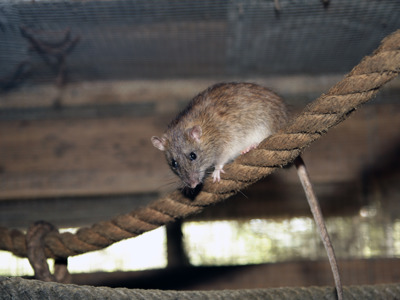
Black Rat
Rattus rattus
Black Rats occur in several colour forms, ranging from black to light brown, although always has a lighter underside. Slightly smaller than the brown rat (150-280g), it has slightly larger ears, pointed nose, slender body and a tail longer than the rest of the body compared to the brown rat.
Behaviour
They are excellent climbers, often found up high in trees and roofs (arboreal). Males and females have similar sized home ranges, although males increase their home range size during the breeding season. They forage together, often after sunset and are extremely flexible in their foraging habits. If foods cannot be eaten quickly, they often hide it in order to eat later.
UK Status
UK introduction thought to have occurred during the Roman times. Not common currently in the UK, quite often displaced by the more aggressive, larger brown rat.
Also, the change in house building material from wooden and thatched to brick and tiled, meant that their arboreal nature would not be an advantage to them. No real population estimate in the UK, and no city sightings since 1978 in Manchester, and 1983 in Liverpool and Glasgow.
Threats
Outcompeted by brown rat, who are better suited for cooler climates. Due to being a species rarely found outside buildings in urban areas, pest control has led to their widespread eradication. Predation by domestic cats is also common.

Distribution
Has a wide global distribution having been introduced across most of Europe, Asia, Australia and New Zealand.
Habitat
Range of habitats. Commensal species (found near human habitation), normally found in residential buildings and warehouses. In rural areas, they can be found in barns and crop fields, trees and cliffs.
Diet
Mainly herbivorous but can be omnivorous. Fruit, agricultural crops, nuts and seeds are their main food items.
Family facts
Possibly the rarest mammal in UK.
Fleas carried by the black rat are thought to have been responsible for the 14th century bubonic plague or “The Black Death” which killed around 40% of people in Europe.
-
![IMG 8912]()
Wildwood animal adoptions last for one year and are the perfect gift for any animal lover. Each adoption helps support our work to save British wildlife. We have different levels of adoption available to suit all occasions and budgets.
ADOPT ME!
-
![IMG 9550]()
Discover the fascinating world of animals through our captivating videos, showcasing their unique behaviours, incredible habitats, and the wonders of nature.
Watch me!



